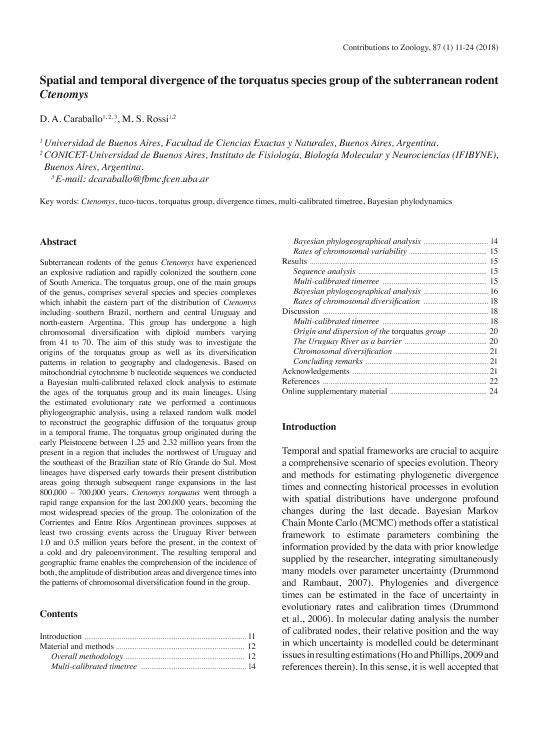Mostrar el registro sencillo del ítem
dc.contributor.author
Caraballo, Diego Alfredo

dc.contributor.author
Rossi, Maria Susana

dc.date.available
2019-11-20T19:07:06Z
dc.date.issued
2018-03
dc.identifier.citation
Caraballo, Diego Alfredo; Rossi, Maria Susana; Spatial and temporal divergence of the torquatus species group of the subterranean rodent Ctenomys; University of Amsterdam; Contributions To Zoology; 87; 1; 3-2018; 11-24
dc.identifier.issn
0067-8546
dc.identifier.uri
http://hdl.handle.net/11336/89315
dc.description.abstract
Subterranean rodents of the genus Ctenomys have experienced an explosive radiation and rapidly colonized the southern cone of South America. The torquatus group, one of the main groups of the genus, comprises several species and species complexes which inhabit the eastern part of the distribution of Ctenomys including southern Brazil, northern and central Uruguay and north-eastern Argentina. This group has undergone a high chromosomal diversification with diploid numbers varying from 41 to 70. The aim of this study was to investigate the origins of the torquatus group as well as its diversification patterns in relation to geography and cladogenesis. Based on mitochondrial cytochrome b nucleotide sequences we conducted a Bayesian multi-calibrated relaxed clock analysis to estimate the ages of the torquatus group and its main lineages. Using the estimated evolutionary rate we performed a continuous phylogeographic analysis, using a relaxed random walk model to reconstruct the geographic diffusion of the torquatus group in a temporal frame. The torquatus group originated during the early Pleistocene between 1.25 and 2.32 million years from the present in a region that includes the northwest of Uruguay and the southeast of the Brazilian state of Río Grande do Sul. Most lineages have dispersed early towards their present distribution areas going through subsequent range expansions in the last 800,000 – 700,000 years. Ctenomys torquatus went through a rapid range expansion for the last 200,000 years, becoming the most widespread species of the group. The colonization of the Corrientes and Entre Ríos Argentinean provinces supposes at least two crossing events across the Uruguay River between 1.0 and 0.5 million years before the present, in the context of a cold and dry paleoenvironment. The resulting temporal and geographic frame enables the comprehension of the incidence of both, the amplitude of distribution areas and divergence times into the patterns of chromosomal diversification found in the group.
dc.format
application/pdf
dc.language.iso
eng
dc.publisher
University of Amsterdam

dc.rights
info:eu-repo/semantics/openAccess
dc.rights.uri
https://creativecommons.org/licenses/by-nc/2.5/ar/
dc.subject
Ctenomys, tuco-tucos, torquatus group
dc.subject
divergence times
dc.subject
multi-calibrated timetree
dc.subject
Bayesian phylodynamics
dc.subject.classification
Genética y Herencia

dc.subject.classification
Ciencias Biológicas

dc.subject.classification
CIENCIAS NATURALES Y EXACTAS

dc.title
Spatial and temporal divergence of the torquatus species group of the subterranean rodent Ctenomys
dc.type
info:eu-repo/semantics/article
dc.type
info:ar-repo/semantics/artículo
dc.type
info:eu-repo/semantics/publishedVersion
dc.date.updated
2019-10-28T19:32:52Z
dc.identifier.eissn
1875-9866
dc.journal.volume
87
dc.journal.number
1
dc.journal.pagination
11-24
dc.journal.pais
Países Bajos

dc.journal.ciudad
Amsterdam
dc.description.fil
Fil: Caraballo, Diego Alfredo. Consejo Nacional de Investigaciones Científicas y Técnicas. Oficina de Coordinación Administrativa Ciudad Universitaria. Instituto de Fisiología, Biología Molecular y Neurociencias. Universidad de Buenos Aires. Facultad de Ciencias Exactas y Naturales. Instituto de Fisiología, Biología Molecular y Neurociencias; Argentina
dc.description.fil
Fil: Rossi, Maria Susana. Consejo Nacional de Investigaciones Científicas y Técnicas. Oficina de Coordinación Administrativa Ciudad Universitaria. Instituto de Fisiología, Biología Molecular y Neurociencias. Universidad de Buenos Aires. Facultad de Ciencias Exactas y Naturales. Instituto de Fisiología, Biología Molecular y Neurociencias; Argentina
dc.journal.title
Contributions To Zoology

dc.relation.alternativeid
info:eu-repo/semantics/altIdentifier/url/https://brill.com/view/journals/ctoz/87/1/article-p11_2.xml
dc.relation.alternativeid
info:eu-repo/semantics/altIdentifier/doi/https://doi.org/10.1163/18759866-08701002
Archivos asociados
